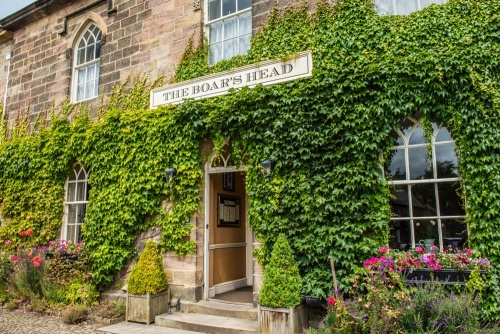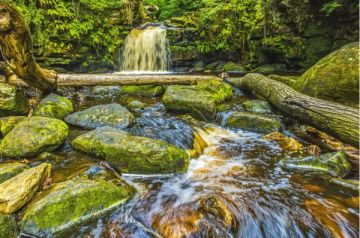
Ripley is a picturesque estate village near Harrogate, best-known as the home of Ripley Castle, one of the great historic houses of England and home to the Ingilby family for over 700 years. The village is modelled on a typical French model village, with houses and public buildings all in the same style and all painted in the Ingilby colours.
The village boasts a post office, florist shop, art gallery, farm shop, and quality food shops, all in the same style of architecture. On a small cobbled area near the village pub is a war memorial and a set of old village stocks for punishing miscreants.

History
Ripley is the only village in England to have been completely rebuilt twice, by the same family, over a span of 700 years! The original village developed further south, on the north bank of the River Nidd. In the 14th century it was rebuilt in its present location by the Ingilby family. Then in the 1830s, Sir William Amcotts Ingilby rebuilt it completely, from the ground up, as a model estate village.
Sir William was inspired by an estate village he saw while travelling in Alsace-Lorraine, in France. When he returned home to England, Sir William tore down the thatched cottages of Ripley and built the entire village from scratch. The architectural style is clearly inspired by Ripley Castle, and even mundane worker's cottages were given Gothic windows.
The highlight of the 'new' Ripley was the Hotel de Ville (town hall), built in 1854 and restored in 2004. The Hotel de Ville was the final building erected by Sir William Ingilby. it seems extraordinary that a village the size of Ripley would have such a grandiose town hall, but Sir William clearly liked to do things in style.

Inside the Hotel de Ville is a huge baronial hall extending the full length of the building. Sir William died in 1854 before the project was complete but his widow Mary Anne took up the challenge and finished her husband's vision.
Opposite the Hotel de Ville is the Ripley Endowed School, founded in 1702 by Mary and Catherine Ingilby, the two youngest daughters of Sir William Ingilby. The main school building was rebuilt in 1830.
Ripley is famous for its ice cream, made locally to a secret recipe. You can get fresh ice cream at the Ripley Ice Cream shop on the main street. Be prepared to queue, especially in summer!

Ripley Castle
One of the great family homes of England, Ripley Castle has been the Ingilby family home since 1308. One of the medieval Ingilbys was Sir Thomas, who was knighted after he saved Edward II from an attack by a wild boar.
The house is a marvellous mix of Tudor and Georgian rooms, with beautiful art and fine furniture. Guided tours tell the story of Ripley and the Ingilby family over the past seven centuries.
The castle stands in superb grounds landscaped by Capability Brown. Then there is the four-acre Victorian walled garden, hosting the National Hyacinth Collection.

One of the most famous episodes in the long history of Ripley Castle came in 1644 when 'Trooper Jane' Ingilby dressed in armour and rode with her brother to join the Royalist army for the Battle of Marston Moor, the largest battle ever fought on English soil. The Royalists under Prince Rupert were badly beaten by Cromwell's Parliamentary army.
The Ingilby's rushed home from the battle, and it's just as well that they did, for Cromwell himself appeared at their door a short time later, demanding that the Ingilbys give him and his men shelter for the night, unaware that the Ingilbys had been fighting against him a few hours earlier.
Sir William hid in a priest hole while Jane greeted Cromwell, armed with a pair of pistols. Pretending to be frightened for her chastity, she made the men sleep in the barn and made Cromwell sleep in a chair while she sat the entire night with the pistols pointed at his chest. Cromwell and his men left the next day.

in All Saints churchyard
All Saints Church
Almost directly opposite the entrance to Ripley Castle is the 14th-century church of All Saints. The church was built around 1395 by Sir Thomas de Ingilby, replacing an earlier chapel known as the 'Sinking Chapel' because it suffered from subsidence. Inside the church are memorials to the Ingilbys of Ripley Castle.
In the churchyard is a 'Weeping Cross', unique in Britain, with niches for pilgrims to kneel around the cross base. You can see holes made by musket balls during the Civil War, when All Saints was occupied by Cromwell's Parliamentary soldiers after the Battle of Marston Moor.
Near the church and castle is The Boars Head, a lovely old coaching inn. The 'boar's head' in the inn name comes from the Ingilby family crest, a reminder of the time Sir Thomas Ingilby saved Edward III from a wild boar. Guests at the Boar's Head get free entry to Ripley Castle.
In 2015 Ripley was named North Yorkshire's best village to live in.

Getting There
Ripley is off the A61 just north of Killinghall. There are roundabouts on the A61 at the north and south ends of the village. There is a large visitor parking area at the south end of the village.
About Ripley
Address: A61,
Ripley,
Yorkshire,
England
Attraction Type: Village
Location: off the A61 about three miles north of Harrogate. Visitor parking at the southern edge of the village.
Location map
OS: SE284605
Photo Credit: David Ross and Britain Express
HERITAGE
 We've 'tagged' this attraction information to help you find related historic attractions and learn more about major time periods mentioned.
We've 'tagged' this attraction information to help you find related historic attractions and learn more about major time periods mentioned.
Find other attractions tagged with:
NEARBY HISTORIC ATTRACTIONS
Heritage Rated from 1- 5 (low to exceptional) on historic interest
Ripley Castle - 0.1 miles (Historic House) ![]()
Ripley, All Saints Church - 0.1 miles (Historic Church) ![]()
Harrogate, St Wilfrid's Church - 3.2 miles (Historic Church) ![]()
Mercer Art Gallery - 3.3 miles (Museum) ![]()
Royal Pump Room Museum, Harrogate - 3.3 miles (Museum) ![]()
Valley Gardens - 3.4 miles (Garden) ![]()
Harrogate, St Peter's Church - 3.4 miles (Historic Church) ![]()
RHS Garden Harlow Carr - 4 miles (Garden) ![]()














